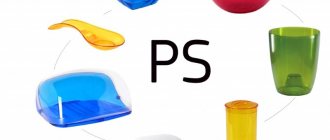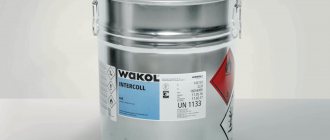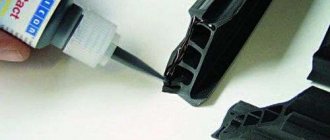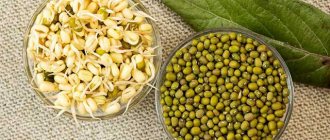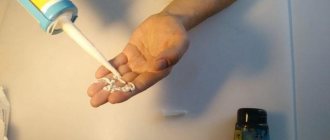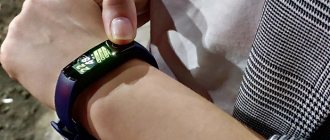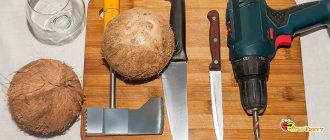In construction, polyethylene film is mostly used as a waterproofing agent or heat insulator when it comes to film greenhouses. Polyethylene has certain soundproofing properties, but not sufficient to use it as an independent sound insulator.
To glue polyethylene, you must first purchase the kind of glue that is used for gluing plastic.
Is it possible to fasten the film with glue?
When it comes to this method of securing two pieces of material, in most cases they buy products called BF-4 or BF-2, which, according to many craftsmen, are ideal for gluing polyethylene of any size or density.
In reality, everything is somewhat different, after treating the edges of the workpieces with a 25% solution of chromic anhydride and applying an adhesive base, the seams began to peel off after a while, for the most reliable connection it was necessary to additionally resort to high temperatures, they took an iron heated to 60 degrees.
As a result, the method was not much different from the usual thermal effect, but the process was delayed in time and brought a lot of inconvenience to the master.
Using super glue - a cutting-edge approach
When faced with a difficult task and deciding how to glue the film in order to get a good result when building a greenhouse or creating a large plain canvas, it is worth paying attention to ordinary factory samples of products, in this case it is super glue.
Up to a certain point, people considered it impossible to carry out manipulations according to such a scheme, but practice has shown the opposite; the approach is truly ultra-modern and practical. Among the advantages of the product are:
- High strength connections.
- No unpleasant odor after hardening.
- Good elasticity.
- Water resistance.
You need to use the product with caution; if it gets on your hands or other areas of the skin, you can easily get burned; the solution is difficult to wipe off from household surfaces due to its potent components.
Is the choice of adhesive for joining workpieces justified?
The toxicity of the composition comes to the fore, which in some cases is unacceptable and can significantly affect the suitability of the products being processed, for example, food; eating such food will be hazardous to health.
It is impossible to check the effectiveness of the liquid in advance, so you need to buy tubes only from time-tested brands, otherwise it will not be possible to avoid unnecessary expenses for the family budget. If you follow the instructions and observe all the rules when performing manipulations, then glue for foamed polyethylene or regular film will do the job perfectly.
It is necessary to start from the area of application of the method, in some situations this approach to the matter will significantly facilitate the work, but on the other hand, it can affect the safety and suitability of the products stored in the wrapper, food will become harmful, things may become saturated with smell, but in a greenhouse or shed for recreation such moments are not scary.
Soldering polyethylene film
Currently, polyethylene film is used in many fields. When performing some types of work, you have to resort to connecting individual parts of this material.
For example, by arranging greenhouses and greenhouses, or to create vapor barrier layers during the construction process. In addition, welding of polyethylene film can be carried out at home.
In the article we will look at the features of joining this material and what equipment you need to use to weld polyethylene film with your own hands.
Methods and methods for welding polyethylene film
Welding polyethylene is the process of joining individual sections of material by heating to the melting temperature and compressing the layers.
When the surfaces of the film are melted, the layers are connected at the molecular level, the result of this procedure is a welding seam.
In order for the quality of the weld to be high and it to be as strong and reliable as possible, it is necessary to select good equipment, strictly follow the welding technology and not make mistakes with the heating temperature. This indicator should vary between 130-160 °C.
Note! If uncleaned areas are welded, then you should not be surprised at the low quality of the joints. Dirt particles entering the molten mass destroy the molecular structure of the seam.
That is why welding of polyethylene film must be carried out in strict compliance with a number of conditions:
- pieces of materials belonging to the same production batch must be welded,
- it is important to choose the right temperature regime; if it is below the norm, the strength will be low; if the specified temperature is exceeded, the joint may be deformed,
- Another prerequisite is clean joining surfaces.
Under no circumstances should areas along the same edges be welded twice.
Also, the success of the work and the quality of the seam are influenced by the welding machine. It is important not only to choose the right device for film welding, but also to be able to handle it.
Equipment
Welding of polyethylene film can be performed using an iron, soldering iron, as well as special industrial devices.
Welding film with a household iron
This method is widely popular. First you need to prepare: for this, a wooden block is placed on the table, and the edges of the film panels are placed on it. Here it is important to ensure that the ends of the material protrude 20 mm from the edges of the bar. A refractory sheet material, such as cellophane or fluoroplastic film, is placed on top of the polyethylene panels.
In order for the process to proceed faster, after you pass the iron over the film, the area to be welded must be cooled, for example, you can use a wet rag.
It is important to control the temperature of the thermostat: it should be 120-150 °C.
The sheets of film need to be folded overlapping, and then a paper sheet should be laid on them. After this, the iron must be tilted 5° and slowly moved along the seam. You won’t be able to get a strong connection the first time; you need to repeat the sequence of actions 4-5 times.
Welders experienced in this matter often use special attachments that are fixed to the electric iron.
The nozzle has a flat ribbed base. It is the ribs that are responsible for connecting sections of polyethylene film. In the soldering area, with the help of a nozzle, two strong seams are formed, placed in parallel.
Welding polyethylene film using a soldering iron
By using a regular soldering iron (40-60 W) to join the film, you can get a strong and reliable seam, but you need to improve the tool a little.
Using a soldering iron without special attachments will not lead to the desired result, because... the joint will turn out uneven, and the material may even spread.
That is why you need to use special attachments that are attached to the device.
You need to take a regular soldering iron, remove the end of the tip, use a hacksaw to create a cut and place an aluminum or copper plate in it and secure it with a rivet.
The surface of the plate must be processed and rounded on all sides with a needle file. The welding process itself is carried out as follows: the soldering iron is pressed at an angle of 45° and moves evenly over the parts being welded.
In the process of creating a joint, experts recommend placing a wooden base under the film.
A wheel can also be used as an attachment. To do this, the end of the tip is also removed and a cut is created that is larger than the radius of the wheel.
A hole is drilled in the body of the tip for the desired wheel axis (3-5 mm), after which an aluminum or copper disk (8-10 mm) is made. The disc is placed in the recess of the tip and fixed by the axis.
The welding process itself consists of rolling a heated soldering iron to the required distance.
Professional devices
To perform large-scale work (for example, to create covers for large greenhouses), it is best to use professional devices for welding polyethylene film. The advantage of such devices is that with them you can adjust the parameters of pressure, temperature and the speed at which it will move along the seam.
If you need to connect sections of polyethylene from the same batch, then once you have set the necessary parameters, the welding process can be carried out very quickly. Typically, such tools are equipped with drive and tension rollers, thanks to which it is possible to pull the film sheets being welded at the same speed.
This ensures high seam quality.
Today, there are various types of industrial devices on the market. They can have both contact heating and heating, which is produced by means of hot air.
The quality of polyethylene welds significantly exceeds the strength and reliability of areas that were connected using adhesive materials.
To summarize, it is worth noting that welding polyethylene at home is not as difficult as it seems at first glance. For this purpose, various devices are provided with which you can obtain a high-quality and durable connection. A soldering iron and iron will help you create a seam in a short time, the main thing is to maintain the accuracy of the technology.
If large-scale work is to be done, then it is better to give preference to professional industrial devices. In any case, the final result will depend on your efforts and care. Also remember that when performing welding work, do not forget about personal safety; gloves and protective clothing will not be superfluous, but, on the contrary, will protect you from accidental burns.
If you have no experience at all, then it is certainly better to turn to specially trained people.
[Total: 1 Average: 4/5]
Soldering film using special equipment - how does this happen?
A bag sealer is a special type of equipment that is used to solder film and finished plastic bags, and also to produce bags from any film material and polymers with the addition of polypropylene.
Today, the modern market offers various types of devices, which can be equipped with pulsed or constant heating, be tabletop or floor-standing, have a pedal drive, and be automatic or manual.
So, for example, to package products with a short shelf life, you can use a device that is equipped with a function that allows you to stamp a date on plastic film.
Types of sealers and their operating principle
The principle of operation of the sealer is as follows. To begin with, a timer is installed on the end of the device, the indicators of which must fully correspond to the thickness of the film and its melting temperature. The position of the equipment is determined experimentally. Next, the material that needs soldering should be laid on the working surface and covered with Teflon tape on top.
In order to activate the bag sealing machine, you need to press the lever. At the same time, a clicking sound is made and the red light installed in the device lights up.
This situation indicates that the process of soldering the polyethylene film has begun.
After the soldering process has come to completion, the red light goes out, which means the plastic bag can be removed from the work surface.
The use of such equipment can be carried out with any types of polyethylene, which include heat-sealable materials, as well as with vacuum bags and films. Now let's take a closer look at some types of sealers.
Open flame welding of film
At the stage of choosing what to glue polyethylene with, many owners of private houses decide to use available means, such as:
- Gas-burner.
- Alcohol lamp.
- Blowtorch.
- Special cans with a nozzle.
- Paraffin candle.
When preparing the site for the process, several bars of metal or ceramic are installed; these structural details will help create, using the fixation method, perfectly smooth edges along which the master will pass with an open flame.
It is enough to allocate a few millimeters of material for soldering; taking wood or other flammable objects is not recommended. After a person runs the selected device along the edge for connection, the two segments become one whole canvas by melting, it is important to correctly select the speed of moving the nozzle along the plane in order to heat it well and not burn the material, which is often determined visually.
Welding with an iron
An important step in polyethylene lap jointing is rapid cooling of the seam area. How to properly join the film with your own hands using an iron:
- lay the material on a wooden or other flat heat-insulating surface;
- place a sheet of thick paper on top;
- the iron is set to the “cotton” mode (the required temperature is 120–150°C);
- the seam is made with the sharp edge of the sole, it is tilted so that there is an angle of 5–10° with the surface of the paper;
- The iron is moved slowly, after which a wet rag is placed on the paper.
To ensure the strength of the seam, the operation is repeated 3–4 times.
Ordinary household iron for gluing polyethylene film
Craftsmen make attachments for irons with metal guides similar to skates. They are used to make double and triple seams. For the manufacture of nozzles the following is used:
- heat-resistant stainless steel, if you have the skills to install it;
- copper-based non-ferrous metals;
- aluminum-magnesium duralumin alloy.
PVC film soldering technology
When consulting beginners, specialists pay attention to two points, without which it is extremely difficult to achieve a positive result; the situation is like this:
- At the first stage, you need to thoroughly clean the soldering area and degrease the surfaces so that the canvas does not stick to the ink.
- When connecting, ensure reliable fixation of the material until complete hardening.
The resulting microscopic holes after making the main connection are simply covered with high-quality sealants; it is important to avoid the appearance of folds, such excesses are difficult to eliminate.
This method has become popular when creating three-dimensional banners; it is easy to make 20 by 30 meter specimens from several blanks, and craftsmen also use polyethylene glue to create reservoirs of up to 500 cubic meters.
Application of polyethylene for greenhouses
PVC-based film is a very versatile material, which was originally invented as a packaging medium. However, the versatility of polyethylene has made it possible to use it much more widely, and today such modern oilcloth is used in many areas, including agriculture. PVC materials made it possible to replace heavy, fragile and expensive glass when covering a greenhouse in the summer.
It is very convenient to use a special welding machine to connect film sheets, and welding can be completed in the shortest possible time
Today, oilcloth made from PVC materials is available in several types:
- Conventional film based on polyethylene. The most popular oilcloth among gardeners for arranging greenhouses and greenhouses. It is characterized by the lowest cost, and its sleeve-shaped design helps to double the covered area. Easy to install with your own hands. The standard service life is one year.
- Reinforced version of PVC materials. It is represented by a plastic or fiberglass mesh welded to sheet material. The standard cell sizes of such polyethylene range from 0.8 x 0.8 to 1.2 x 1.2 centimeters. This PVC material is characterized by heterogeneity of structure and thickness, and when choosing, you should pay attention to the density parameters.
- PVC films. They provide serious competition to standard polyethylene film when arranging greenhouses. PVC film has excellent physical and chemical properties, which allows the coating to transmit the light spectrum necessary for the growth and development of greenhouse crops. In addition, PVC materials are more resistant to low temperatures, and their service life is at least five years.
- Other types of films for greenhouses. Copolymer, polyamide and air bubble films fall into this category. Manufacturers position such options as frost-resistant and do not require dismantling for the winter period. However, the high price makes it not very popular for covering greenhouses among Russian gardeners.
Today, oilcloth made from PVC materials is available in several types.
A definite advantage of any film covering is the ability to cover the greenhouse yourself. But it should be taken into account that greenhouse structures of non-standard size, as well as protected ground structures with a complex configuration, may require gluing several elements of material into a single fabric. We also recommend that you read the article on how to choose the right film for a greenhouse.
Source of the article: https://mirfruktoeda.ru/teplica/kak-skleit-armirovannuyu-plenku.html
Glue marking
When you come to a specialized store to make a purchase, you don’t have to immediately contact a sales consultant; having useful information about deciphering the abbreviation on the tube, you can independently select the ideal sample of the product. The most common symbols on packaging are:
- PC - polycarbonate.
- ABS copolymer of acrylonitrile.
- PP-polypropylene.
- PPMA-organic glass.
- PE-polyethylene.
- PVC-polyvinyl chloride.
- PS-polystyrene.
- PA 66-polyamide.
- PUR-polyurethane.
You can find information not only on the bottle itself, but also in the instructions, which are always included with products from reputable brands. Keeping in mind the subtleties of labeling, you can also check the relevance of the seller’s advice, because such employees are interested in selling the product and are often not very attentive to the specific goal pursued by the consumer.
Brands of connecting tape
To decide which product is exactly right for the task at hand, you need to familiarize yourself in advance with the popular types of adhesive tape that helps connect the film material.
When deciding how to glue plastic film at home, you can use just such a device to significantly facilitate the process of fixing the workpieces and not waste a lot of time working with an open flame; specialized equipment will lead to injuries or burns if handled carelessly.
"Izospan SL"
The product is excellent for creating good joints of hydro- and vapor barriers; initially, the material was used during the construction of roofs to fix protective layers to different structures of parts. The use of adhesive tape near chimney pipes is not excluded, which indicates the resistance of Izospan to elevated temperatures.
When studying information about the strength of the connection, each consumer will find an indicator on the packaging equal to 0.1 MPa, but it is not recommended to glue pieces to metal in this way; adhesion decreases several times. Experts consider a water absorption of 0.2% to be an excellent indicator; the operating temperature varies from -60 to +140 degrees.
"TechnoNIKOL"
A distinctive feature is the presence of two adhesive sides. When deciding how to glue polyethylene foam, you can safely take note of products from this brand, the material performs its basic functions well.
The length of the roll is often at least 25 meters, the width is 3.8 cm, TechnoNIKOL adhesive tape was developed only to connect blanks from components sold by this brand, but through trial and error the effectiveness of combining with canvases from other ml and bl
A service life of 15 years will surprise even the most skeptical buyer; the “ml” model has an adhesive composition on both sides of the tape, rolls are produced 25 meters long, and the strip width is 50 mm. The “bl” variety is excellent for sealing joints of hard surfaces; it is possible to achieve high-quality adhesion to a brick, concrete or wooden wall.
Nicoband
Expensive products have a tape width of 100 mm, a roll contains 10 meters of tape, and the product is available in several colors.
Mounting tape is often used to seal seams located outside the building; a 10-year warranty attracts the attention of consumers. Excellent for bonding polyethylene to plaster, metal or roofing.
Application of acrylate glue with filler
This technique is chosen for working with materials that have poor adhesion. Liquids are difficult to adhere to polyethylene material. Adhesives with tiny glass beads are used to hold liquids in one area. This way, the necessary area for gluing is obtained, and after hardening, tightly fixed parts are obtained. Before gluing the oilcloth together, it is degreased and dried.
The adhesive composition is applied with a special mixer. Setting occurs in 2-3 minutes.
This technique is chosen for working with materials that have poor adhesion.
Welding film for a greenhouse
Step-by-step instructions for gluing polyethylene when creating a structure in the garden or in the local area look like this:
- Two pieces of material are thoroughly cleaned of dirt.
- If necessary, place filler between layers.
- They start heating up, after melting the edges you need to stop and let them “settle”.
- Without delaying the process for a long time, dock the surface and compress tightly.
- Allow the seam to cool.
To implement your plans outdoors, it is better to resort to using a special construction hair dryer, which can raise the temperature to 250 degrees, and the modes can be adjusted depending on the weather.
We glue the film at home
Avoiding calling specialists, some owners are wondering how to glue foamed polyethylene to metal, concrete or to each other. It is important to strictly follow the technological process, as well as consistently perform manipulations.
Often, repairing a roof, creating greenhouses or various canopies is not possible without connecting workpieces, so effective tips will definitely come in handy in everyday life.
Between themselves
Most often, BF-2 glue is used to implement an idea; this liquid dries out quite quickly, which speeds up the work of a team of builders or a person who has taken it upon himself to complete the job.
The edges need to be cleaned of dirt and degreased with acetone or technical alcohol, a thin layer of the product is applied to the surface of the material and the two workpieces are quickly combined with each other. For complete polymerization and hardening, it should be left for at least 24 hours, after which you can safely use the created canvas.
To metal
The metal base needs to be cleaned; special abrasive brushes are suitable for this; sandpaper will help to bring the surface to perfection, after which you will need to degrease the area.
The metal must be heated to a temperature of 110-150 degrees; for this it is better to take a filled blowtorch or a large gas cylinder. To bond, it is enough to press the film against the workpiece and smooth the surface with a roller, at which point the polymer will melt.
To concrete
After leveling the plane, it must be primed, for work, buy an adhesive base and apply the composition to the polypropylene from the side where there is no foil or other protective layer, if any.
It is worth reading the instructions in advance and following the manufacturer’s recommendations; often the brand advises to wait until the layer sets and is well absorbed into the material, only then begin to press the workpiece onto the concrete.
Other options
If the fixation needs to be done here and now, and the adhesive base is not available, you can use a household iron. Paper is placed on top of the two soldered edges to prevent the polymer from sticking to the heating surface of the device.
With the help of an open fire, you can also achieve good results by first connecting two pieces, just bring them to the flame, but the seam may not be as smooth as the owner of the building would like.
How to glue with epoxy glue
The surface is first degreased; application of HDPE glue is possible only on a dry surface. Both items are treated with special substances; it is safer to choose highly concentrated potassium permanganate. After this stage, they again wait for the products to dry. Epoxy is prepared according to the manufacturer's instructions. Glue is applied to both objects and they are pressed against each other. Secure in this position. Provided that the temperature varies from +30 to +45 degrees, it will take several hours to complete polymerization. At room temperature 24 hours.
During work, you need to wear protective clothing and gloves, it is advisable to wear a respirator, and good ventilation must be provided in the room. To prevent resin from getting into your eyes, use safety glasses.
During work, you need to wear protective clothing and gloves, and it is advisable to wear a respirator.
How to solder film
In addition to the popular brands BF-2 or BF-4, sometimes 80% acetic acid is used to implement the plan. Do not forget about the pre-treatment of two planes with chromic anhydride with an indicator on the package of 25%.
For fixing polyamide film, a specialized composition PK-5 is often purchased, but with this approach to the process without ironing with a heated iron, it will be difficult to obtain a reliable seam. One bottle of solution of 50 ml should be enough for a joint of 15-20 meters, if you take a serious approach to manipulation technology.
When choosing super glue, you also need to be careful and follow precautions, as with all other types of compounds. Such cutting-edge products can be useful in repairing polymer canvas; to do this, it is enough to apply a thin layer of the product and apply a patch, pre-cut to size.
To use the product, you should wait 2 hours, which is considered an excellent result; old samples of the material are no less productive and reliably connected, but it is better to work outside only in sunny weather.
Characteristics of reinforced film for greenhouses
The indicators of the material are most often paid attention to by owners of country houses who want to purchase film and not be upset about the service life; how long the greenhouse will last directly depends on the choice of canvas. Experts advise looking at the following characteristics:
- Roll length.
- Width.
- Density per 1 cubic meter cm.
- Color design.
The polymer material must transmit at least 75% of sunlight so that the gardener can save on additional lighting. In bad weather, the frame can remain undamaged only if you buy the most durable film samples, and over time, the destructive effects of the environment will not affect the integrity of the canvas.
Hot gluing methods
To use the most common gluing method, you will need an iron or soldering iron and (optional, but recommended) fluoroplastic tape. You can also use an iron roller heated to 250C. Place the panels to be glued on top of each other and slowly move the iron or soldering iron tip through the fluoroplastic tape. The overlap width should be 1-2 cm. If there is no fluoroplastic tape, then plain paper or even a strip of newspaper that needs to be folded in half will do. Before starting gluing, it is best to practice to find the optimal holding time. Carry out the gluing process together: an assistant should stretch the film while smoothing it. After the job is completed, do not rush to tear off the strips of paper, otherwise you may damage the film. The second method is to use wide strips of metal (5-10 cm) and a blowtorch. Clamp the two panels to be glued between the strips of metal and a flat surface so that there is an overlap of 1-1.5 cm. Next, heat this place with a blowtorch, being careful not to overheat the metal and melt the film underneath.
